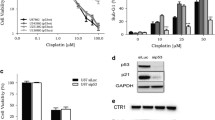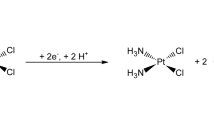Abstract
To cast light on the mechanisms of drug-resistance, experimental brain tumors were immunohistochemically evaluated for expression of glutathione S-transferase (GST)-α, µ, π, p-glycoprotein and apoptosis-related factors, such as bcl-2 and p53, as well as by the terminal deoxynucleotidyl transferase-mediated dUTP-biotin nick end labelling (TUNEL) method. Rat brain tumors induced by means of prenatal exposure to ethylnitrosourea (ENU) were treated with 1-(4-amino-2-methyl-5-pyrimidinyl)methyl-3-(2-chloroethyl)-3-nitrosourea hydrochloride (ACNU) and/or vincristine. Tumors more than 2 mm in size were considered to be drug resistant. The expression of GST-µ was strongly positive in ACNU-treated brain tumors, while p-glycoprotein was overexpressed in vincristine-treated brain tumors. Neither p53 nor bcl-2 expression directly correlated with apoptosis identified by TUNEL method, but tumors lacking apoptotic cells always demonstrated the expression of either GST-µ or p-glycoprotein. These results indicate that tumors resistant to chemotherapy might not be susceptible to induction of apoptosis, and therefore that mechanisms of drug resistance are related to programmed cell death in brain tumors.
Similar content being viewed by others
References
Feun LG, Savaraj N, Landy HJ: Drug resistance in brain tumors. J Neuro-Oncol 20: 165–196, 1994
Juliano RL, Ling VA: A surface glycoprotein modulating drug permeability in Chinese hamster ovary cell mutants. Biochem Biophys Acta 455: 152–162, 1976
Kiwit JCW, Hertel A, Matuschek AE: Reversal of chemoresistance in malignant gliomas by calcium antagonists: correlation with the expression of multidrug-resistant p-glycoprotein. J Neurosurg 81: 587–594, 1994
Moscow JA, Fairchild CR, Madden MJ, Ransom DT, Wieand HS, O'Brien EE, Poplack DG, Cossman J, Myers CE, Cowan KH: Expression of anionic glutathione-S-transferase and p-glycoprotein genes in human tissues and tumors. Cancer Res 49: 1422–1428, 1989
Cordon-Cordo C, O'Brien JP, Casals D, Rittman-Grauer L, Biedler JL, Melamed MR, Bertino J: Multidrug-resistance gene (P-glycoprotein) is expressed by endothelial cells at blood-brain barrier sites. Proc Natl Acad Sci USA 86: 695–698, 1989
Grant R, Ironside JW: Glutathione S-transferases and cytochrome p450 detoxifying enzyme distribution in human cerebral glioma. J Neuro-Oncol 25: 1–7, 1995
Hara A, Niikawa S, Zhang W, Sakai N, Yamada H, Yoshimi N, Mori H: Identification of placental form of glutathione S-transferase in ACNU-resistant murine glioma cell lines. J Neuro-Oncol 17: 205–213, 1993
Smith MT, Evans CG, Doane-Setzer P, Castro VM, Tahir MK, Mannervik B: Denitrosation of 1,3-bis(2-cloroethyl)-1-nitrosourea by class mu glutathione transferase and its role in cellular resistance in rat brain tumor cells. Cancer Res 49: 2621–2625, 1989
Black SM, Wolf CR: The role of glutathione-dependent enzymes in drug resistance. Pharma Ther 51: 139–154, 1991
Kitahara A, Satoh K, Sato K: Properties of the increased glutathione S-transferase A form in rat preneoplastic hepatic lesions induced by chemical carcinogens. Biochem Biophys Comm 112: 20–28, 1988
Mannervik B, Jensson H: Binary combinations of four protein subunits with different catalytic specificities explain the relationship between six basic glutathione S-transferases in rat liver cytosol. J Biol Chem 257: 9909–9912, 1982
Mineura K, Izumi I, Watanabe K, Kowada M: Enhancement of ACNU cytotoxicity by pretreatment with O 6-methylguanine in ACNU-resistant brain tumors. J Neuro-Oncol 19: 51–59, 1994
Ling Y-H, Priebe W, Perez-Soler R: Apoptosis induced by anthracycline antibiotics in P388 parent and multidrug-resistant cells. Cancer Res 53: 1845–1852, 1993
Evans DL, Dive C: Effects of cisplatin on the induction of apoptosis in proliferating hepatoma cells and nonproliferating immature thymocytes. Cancer Res 53: 2133–2139, 1993
Eastman A: Activation of programmed cell death by anticancer agents: cisplatin as a model system. Cancer Cells 2: 275–280, 1990
Carson DA, Ribeiro JA: Apoptosis and disease. Lancet 341: 1251–1254, 1993
Gavrieli Y, Sherman Y, Ban-Sasson SA: Identification of programmed cell death in situ via specific labelling of nuclear DNA fragmentation. J Cell Biol 119: 493–501, 1992
Jones EL, Searle CE, Smith WT: Tumours of the nervous system induced in rats by the neonatal administration of N-ethyl-nitrosourea. J Pathol 109: 123–139, 1973
Druckrey H, Ivankovic S, Preussmann R: Teratogenic and carcinogenic effects in the offspring after a single injection of ethylnitrosourea to pregnant rats. Nature 210: 1378–1379, 1966
Grossi-Paoletti E, Paoletti P, Pezzotta S, Schiffer D, Fabiani A: Tumors of the nervous system induced by ethylnitrosourea administered either intracerebrally or subcutaneously to newborn rats. Morphological and biochemical characteristics. J Neurosurg 37: 580–590, 1972
Ali-Osman F, Stein DE, Renwick A: Glutathione content and glutathione S-transferase expression in 1,3-bis(2-cloroethyl)-1-nitrosourea-resistant human malignant astrocytoma cell lines. Cancer Res 50: 6976–6980, 1990
Gunji H, Kharbanda S, Kufe D: Induction of internucleosomal DNA fragmentation in human myeloid leukemia cells by 1-b-D-arabinofuranosylcytosine. Cancer Res 51: 741–743, 1991
Borner MM, Myers CE, Sartor O, Sei Y, Toko T, Trepel JB, Schneider E: Drug-induced apoptosis is not necessarily dependent on macromolecular synthesis or proliferation in the p53-negative human prostate cancer cell line PC-3. Cancer Res 55: 2122–2128, 1995
Collins RJ, Harmon BV, Souvlis T, Pope JH, Kerr JFR: Effects of cycloheximide on B-chronic lymphocytic leukaemia and normal lymphocytes in vitro: induction of apoptosis. Br J Cancer 64: 518–522, 1991
Wyllie AH, Morris RG, Smith AL, Dunlop D: Chromatin cleavage in apoptosis: association with condensed chromatin morphology and dependence upon macromolecular synthesis. J Pathol 142: 62–67, 1984
Hartwell LH, Weinert TA: Checkpoints: controls that ensure the order of cell cycle events. Science 246: 629–634, 1989
Lotem J, Sachs L: Regulation by bcl-2, c-myc, and p53 of susceptibility to induction of apoptosis by heat shock and cancer chemotherapy compounds in differentiation-competent and-defective myeloid leukemic cells. Cell Growth & Differ 4: 41–47, 1993
Lowe SW, Ruley HE, Jacks T, Housman DE: p53-dependent apoptosis modulates the cytotoxicity of anticancer agents. Cell 74: 957–967, 1993
Fisher D: Apoptosis in cancer therapy: crossing the threshold. Cell 78: 539–542, 1994
Reed JC: Bcl-2 and regulation of programmed cell death. J Cell Biol 124: 1–6, 1994
Kokunai T, Sawa T, Tamaki N: Localization of apoptotic cells in situ of brain tumors. Brain Tumor Pathol 12: 15–21, 1995
Schiffer D: On the occurrence of oligodendroglioma-like areas in neurinomas experimentally induced in the rat by nitrosourea derivatives. J Neurol Sci 19: 45–52, 1973
Vaquero J, Oya S, Coca S, Zurita M: Experimental induction of primitive neuro-ectodermal tumours in rats: a reappraisement of the ENU-model of neurocarcinogenesis. Acta Neurochir 131: 294–301, 1994
Ikeda T, Mashimoto H, Iwasaki K, Shimokawa I, Matsuo T: A sequential ultrastructural and histoautoradiographic study of early neoplastic lesions in ethylnitrosourea-induced rat glioma. Acta Pathol Jpn 39: 487–495, 1989
Cabral FR, Brady RC, Schlber MJ: A mechanism of cellular resistance to drugs that interfere with microtubule assembly. Ann NY Acad Sci 46: 748–756, 1986
Lee WC, Lin KY, Chen KN, Lai YK: Induction of HSP70 is associated with vincristine resistance in heat-shocked 9L rat brain tumor cells. Br J Cancer 66: 653–659, 1992
Nakamura M, Tsunoda S, Sakaki T, Konishi N, Hiasa Y: Immunohistochemical and biochemical studies on the expression of glutathione S-transferase-??in human brain tumors. Brain Tumor Pathol 9: 49–54, 1992
Ali-Osman: Quenching of DNA cross-link precursors of chloroethylnitrosoureas and attenuation of DNA interstand cross-linking by glutathione. Cancer Res 49: 5258–5261, 1989
Author information
Authors and Affiliations
Rights and permissions
About this article
Cite this article
Yabuno, T., Konishi, N., Nakamura, M. et al. Drug resistance and apoptosis in ENU-induced rat brain tumors treated with anti-cancer drugs. J Neurooncol 36, 105–112 (1998). https://doi.org/10.1023/A:1005878402133
Issue Date:
DOI: https://doi.org/10.1023/A:1005878402133




